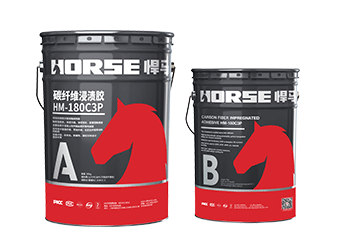Solutions
Horse Construction offers full range of structural strengthening materials with technical supports, documentation supports, products supports, project supports.
CFRP strengthening
Carbon fiber sheet (CFRP) reinforced concrete structure is a new technology that uses high-performance composite materials to reinforce the structure. In my country, the National Industrial Building Diagnosis and Renovation Engineering Technology Research Center first carried out the research work of CFRP reinforcement and reinforcement of reinforced concrete members in 1997. Subsequently, some universities and the China Building Materials Research Institute and other scientific research institutes also carried out research on this technology. In recent years, with the implementation of the national primary and secondary school building safety project and the seismic reinforcement and reconstruction project of old residences, the technology of CFRP reinforced concrete structures has been widely used. The amount of reinforcement works has increased rapidly, and the inspection work related to construction acceptance has also increased significantly.
Standards and technical specifications related to this technology include "Technical Specification for Carbon Fiber Sheet Reinforced Concrete Structures", "Carbon Fiber Sheets for Structural Reinforcement and Repair", "Adhesive Resins for Fiber Sheet Reinforced and Repaired Structures", "Code for Design of Reinforcement of Concrete Structures", "Code for Construction Quality Acceptance of Building Structure Reinforcement Projects", etc. The issuance and implementation of standards and technical specifications further standardize CFRP product requirements and the design and construction in the field of concrete structure reinforcement, thus promoting the promotion of CFRP reinforcement of concrete structures.
The principle of CFRP reinforced concrete structure is to stick the carbon fiber sheet to the surface of the component through the matching adhesive, so that the carbon fiber sheet can bear the tensile force, coordinate with the concrete deformation, and receive the force together to achieve the purpose of reinforcement. The method of pasting carbon fiber can effectively improve the bending bearing capacity and deformation capacity of the existing structure, and improve the mechanical properties. The test results show that when the number of fiber cloths is sufficient, the damage of the fiber cloth is a single peeling failure, and most of the peeling failures occur on the concrete in the range between the concrete surface layer and the steel protection layer. Concrete strength is the most important factor affecting the peeling failure between carbon fiber cloth and concrete. The success of CFRP-reinforced concrete structures mainly depends on the bonding performance between carbon fiber cloth and concrete. In a considerable number of documents, on-site acceptance only uses a hammer and other tools to check the bonding effect, or uses the method in the obsolete old version of the standard for evaluation. Such a judgment method is inappropriate. Whether the construction quality is qualified or not, the bonding strength must be inspected on site to give a more reliable assessment.
Requirements for conformity assessment in standard specifications
When using carbon fiber cloth to reinforce concrete components, the bonding interface between carbon fiber cloth and concrete will be in a complex stress state, and the bonding failure mode is not exactly the same. The test results show that there is a good correlation between the bond strengths of the four modes: normal tension, push-shear, tension-shear, and bending-tension. Among them, the correlation between the positive tensile bond strength and the square root of concrete compressive strength is the best. The positive tensile bond strength index between carbon fiber cloth and concrete can truly reflect the bonding performance between the two, at the same time it is easy to test and has stability, the measured data is small in dispersion, and the test is convenient. The aging test was carried out according to the specified environmental conditions, and the positive tension bond strength decreased significantly. Therefore, in the field inspection, the method of testing the positive tension bond strength is selected to evaluate the construction quality of the project.
On-site inspection and conformity assessment of the construction quality of reinforced concrete with carbon fiber sheets currently available standards include "Specifications for Design of Reinforcement of Concrete Structures", "Construction Quality Acceptance Specification for Reinforcement of Building Structures" and "Technical Specification for Carbon Fiber Sheet Reinforcement and Repair of Concrete Structures".
The three standards all use the method of on-site inspection of the positive tension bond strength to carry out the conformity assessment of the construction quality, and the test results are jointly expressed by the test result of the positive tension bond strength and the failure form. However, the limit values used in the three standards are not uniform. In actual inspection work, different standards may be used for evaluation and different conclusions may be drawn, which brings greater uncertainty to the acceptance work.
The requirements of the three standards for conformity assessment are as follows:
1) GB50367
The positive tensile bonding strength of each sample in the group meets the requirements of the corresponding index of the specification, and the failure mode is normal.
2) GB 50550
The positive tensile bond strength of each sample in the group reached 1.5MPa or more, and the failure mode was normal.
3) CECS146
The positive tensile bond strength of each sample in the group reached the requirement of max{1.5,ftk}, and the failure mode was normal. ftk is the measured tensile strength standard value of the original component concrete
You can find anything here you are in need of, have a trust trying on these products, you will find the big difference after that.

Good impregnation carbon fiber adhesive for applying carbon fiber reinforced polymer(CFRP) wrap for structural strengthening

High strength carbon fiber reinforced polymer (CFRP) strip / laminate / plate for structural strengthening and concrete repair

High strength, unidirectional carbon fiber fabric pre-saturated to form a carbon fiber reinforced polymer (CFRP) fabric used to strengthen structural concrete elements.